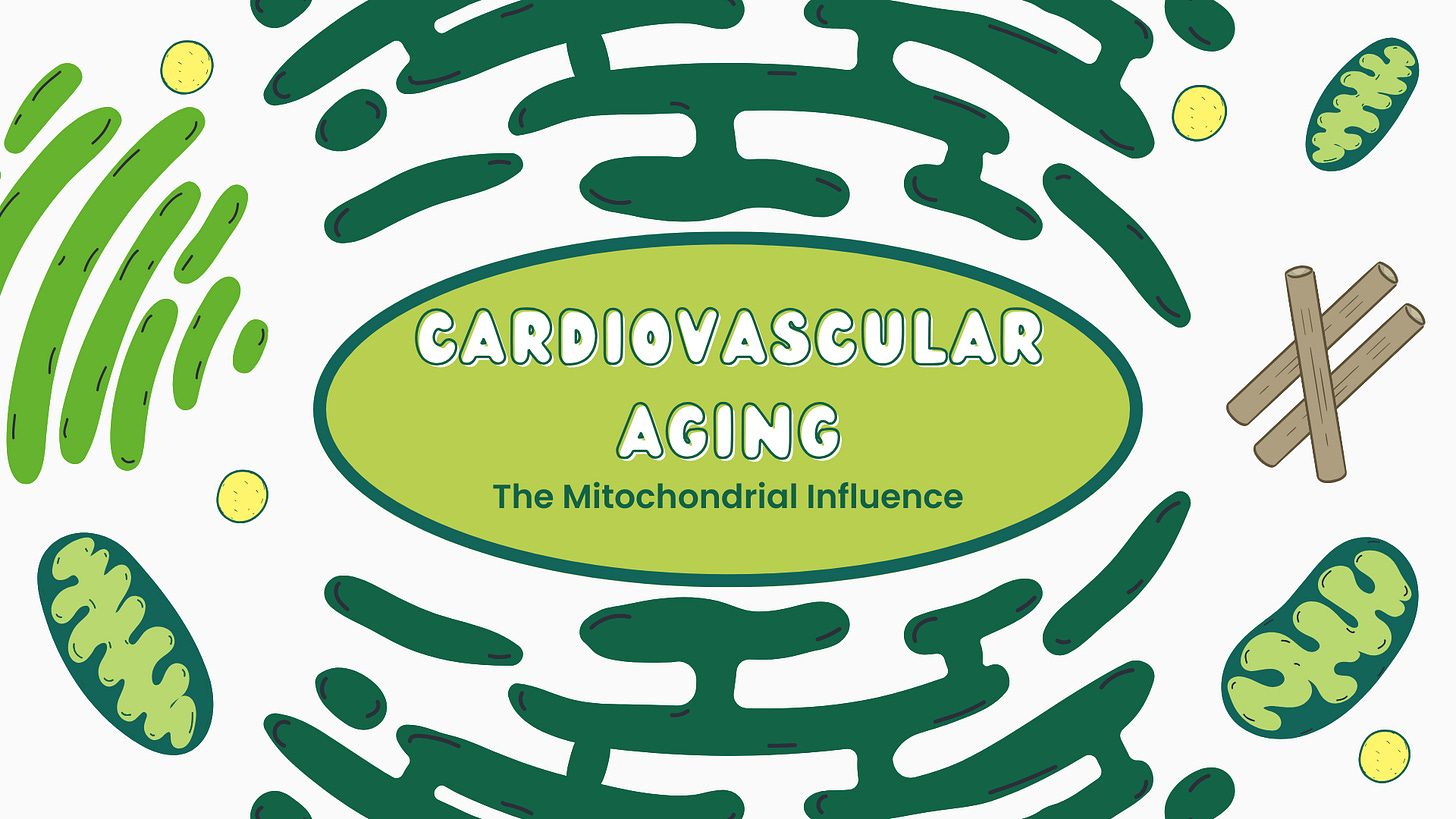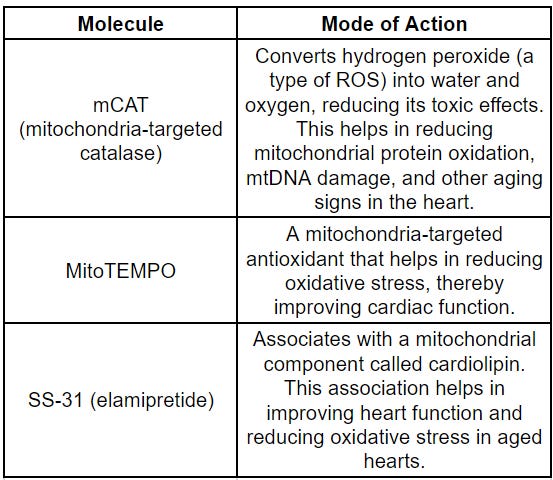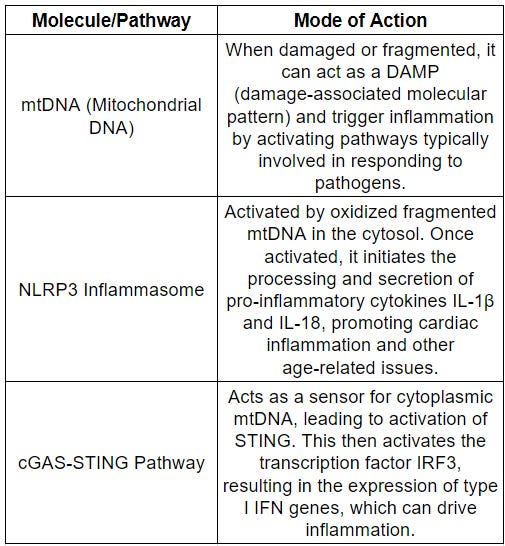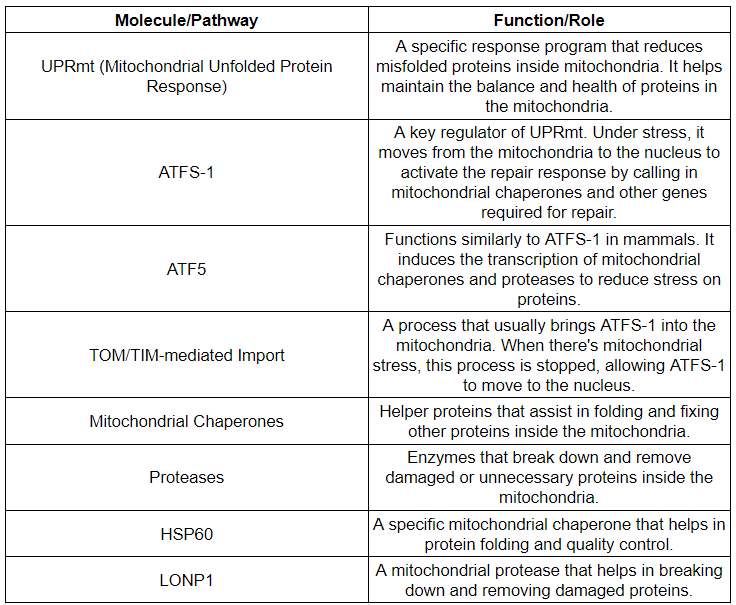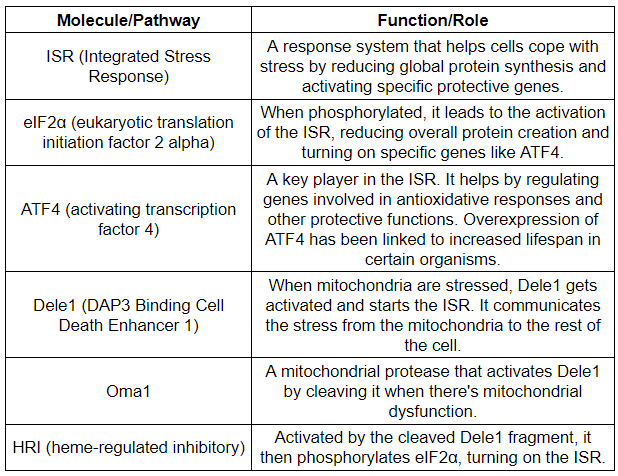Unlock the Secrets to a Youthful Heart!
Discover the Miracle Molecules that Supercharge Your Heart's Batteries and Beat Aging!
Today, we’ll be talking about our hearts and how they're powered.1 Imagine your heart as a car engine. Just like a car needs fuel to run, our hearts need energy too. This energy comes from tiny powerhouses inside our cells called mitochondria. But as we get older, these mitochondria can sometimes not work as well. And when that happens, our hearts can face some challenges.
tl;dr: Mitochondria are essential cell components responsible for producing energy. They are hardworking in heart cells. As we age, these mitochondria can become less efficient and even damaged. Various processes in our cells, like oxidative stress, protein quality control, stress response, and autophagy, play roles in maintaining mitochondrial health. When these processes are disrupted, it can lead to heart issues and other age-related problems. Key molecules and pathways, such as ROS, UPRmt, ISR, and PINK1-Parkin, help regulate these processes. By understanding and potentially enhancing these pathways, we might improve heart health and longevity.
Why Are We Living Longer?
First, the good news! Thanks to better health care, clean living, good food, and smart choices, people are living longer than ever before. In the US, the average person can expect to live up to around 76 years. That's pretty awesome, right? But there's a catch. Living longer means we might face some health problems that come with age, like heart issues.
Why the Heart Needs Energy
Our hearts are always working, always beating. That takes a lot of energy! Most of this energy comes from our mitochondria. These tiny parts of our cells are like mini power plants. But they do more than just make energy. They help with other important jobs in our cells and even help decide when a cell should stop working.
The Challenge with Aging
As we get older, our mitochondria might not work as well as they used to. Think of them like old batteries that don't hold a charge as long. When this happens, our hearts can't get all the energy they need. Plus, these older mitochondria can sometimes make things called ROS, which can be harmful to our cells.
Let’s dive deep into our hearts to explore the tiny powerhouses called mitochondria. These little guys are super important for our heart's health, especially as we grow older. Let's break it down in a way that's easy to understand.
The Tiny Power Plants: Mitochondria
Imagine your heart as a busy city, and the mitochondria are the power plants. These power plants produce energy for the city to run smoothly. But sometimes, they can create waste, just like real power plants. This waste is called ROS (Reactive Oxygen Species).
What's the Deal with ROS?
When our heart's power plants (mitochondria) make energy, they sometimes produce ROS as a side effect. Think of ROS as smoke coming out of a factory. A little bit of smoke is okay because the city has ways to clean it up. But too much smoke can cause problems.
The Problem with Too Much ROS
If there's too much ROS (or too much smoke), it can damage the city (our heart). This damage can make our heart not work as well as it should. As we get older, our heart's cleaning system might not work as well, so more ROS can hang around and cause trouble.
How Can We Help Our Heart?
Scientists have found some cool ways to help our hearts deal with ROS. They've made special tools, like mCAT and MitoTEMPO, that help clean up the ROS. Think of them as super-powered fans that blow the smoke away. When they used these tools in older mice, their hearts worked better!
Our heart has tiny power plants called mitochondria that make energy. But sometimes, they produce ROS, which can be harmful. As we age, it's essential to understand how to keep our heart's power plants running smoothly and reduce the ROS.
Mitochondria's Special DNA
Our cells have a special kind of DNA just for mitochondria (mtDNA). Think of it as a unique instruction manual for these tiny power plants. But there's a catch. mtDNA is close to where energy is made, and it doesn't have a strong shield. So, it can get damaged easily.
Why Does This DNA Get Damaged?
When mitochondria make energy, they sometimes produce waste called ROS. This ROS can harm the special mtDNA. Over time, this mtDNA can have mistakes, like missing pages in an instruction manual. These mistakes can make our heart and other parts of our body not work as well.
The Link Between Damaged DNA and Aging
Scientists have noticed that as people get older, their mtDNA has more mistakes. Some studies even found that older folks with more DNA mistakes had weaker muscles, slower thinking, and more heart problems. Some even had a higher risk of memory diseases and strokes.
What About Mice with mtDNA Mistakes?
Scientists studied special mice with lots of mtDNA mistakes. These mice got old faster and had problems like weak bones, hair loss, and a bent back. Their hearts also got bigger and didn't work as well. This showed that DNA mistakes can make creatures age faster.
The Cycle of Damage
Here's the tricky part: when mtDNA gets damaged, it can make even more ROS. This ROS can cause more damage, and the cycle goes on. This cycle might be a big reason why we age and get diseases as we grow older.
Mitochondrial DNA (mtDNA) is more vulnerable to oxidative damage for several reasons:
Proximity to ROS Production: Mitochondria are the primary sites where ROS are produced in the cell. The mtDNA is located very close to the electron transport chain, where these ROS are generated. Because of this closeness, mtDNA is more exposed to ROS than the DNA in the cell nucleus.
Lack of Protective Histones: In the cell nucleus, DNA is wrapped around protective proteins called histones. These histones help shield nuclear DNA from damage. However, mtDNA doesn't have these protective histones, making it more exposed and vulnerable to damage.
Limited DNA Repair Mechanisms: While the cell nucleus has robust mechanisms to repair damaged DNA, mitochondria have fewer and less efficient DNA repair tools. This means that once mtDNA is damaged, it's less likely to be properly repaired compared to nuclear DNA.
Continuous Exposure to Energy Production: Since mitochondria are always active in producing energy for the cell, there's a constant risk of ROS production and, consequently, a continuous threat to mtDNA.
Single-Stranded Loops: Parts of mtDNA are single-stranded, unlike the double-stranded structure of nuclear DNA. Single-stranded DNA regions can be more susceptible to damage than double-stranded areas.
Because of these factors, mtDNA is particularly susceptible to oxidative damage, which can lead to mutations and impact the proper functioning of mitochondria and, by extension, the health of the cell.
Inflammation
Let's chat about our heart, tiny power plants inside our cells called mitochondria, and something called inflammation. It might sound complicated, but don't worry, we'll make it easy to understand!
What is Inflammation?
Imagine you get a small cut on your finger. It becomes red and a bit swollen, right? That's your body's way of healing the cut. That's inflammation in action! But sometimes, our body gets a little confused and thinks it needs to heal when it doesn't. This can cause problems, especially as we get older.
Tiny Batteries and Inflammation
Our tiny cell power plants, the mitochondria, have their own special DNA. Sometimes, this DNA can get damaged. When this happens, our body might think there's an invader, like a germ, and start the inflammation process. This can cause problems for our heart and other parts of our body.
How Mitochondria Talk to Our Body
When mitochondria's DNA gets damaged, it can send signals to our body. One of these signals goes to a team called the NLRP3 inflammasome. This team can make our heart and body feel more inflamed. Some smart mice that didn't have this NLRP3 team stayed healthier and lived longer!
Another Way Mitochondria Talk
There's another way mitochondria can send signals. It's through a pathway called cGAS-STING. This pathway can also make our body feel more inflamed. In some special mice with lots of mitochondrial DNA mistakes, this pathway was always on, making them age faster.
Why This Matters
When our mitochondria's DNA gets damaged, it can make our body feel like it's always trying to heal, even when it doesn't need to. This can make our heart and other parts of our body not work as well as they should. But the good news is, scientists are learning more about this every day, and they're finding ways to help!
The Repair Team Inside Our Tiny Batteries
Inside our tiny power plants (mitochondria), there are special workers called proteins. Sometimes, these workers can get tired or make mistakes. But don't worry! There's a special repair team ready to help. This team is called the UPRmt.
How Does the Repair Team Know When to Help?
Imagine you're in a big factory, and a machine breaks down. You'd probably ring a bell or sound an alarm, right? The mitochondria do something similar. When things go wrong, they send a signal to the cell's control room (the nucleus) to ask for help. This is where our hero, ATFS-1, comes in!
Meet the Hero: ATFS-1
ATFS-1 is like a superhero for our tiny power plants. Usually, ATFS-1 stays inside the mitochondria. But when there's trouble, it moves to the control room to start the repair process. It calls in more helpers, like chaperones and proteases, to fix the tired or mistaken proteins.
Why This Repair Team is Super Important
Having a good repair team means our tiny power plants can keep working well. And when they work well, our hearts and bodies stay healthy. Some tiny creatures, like worms, have shown that when their repair team is active, they live longer! Even some special mice with a strong repair team seem to live a healthier and longer life.
When Our Tiny Batteries Feel Stressed
Just like us, our tiny power plants can feel stressed too. When they do, they have a special way to deal with it called the Integrated Stress Response (ISR). Think of it as a special alarm system that helps the mitochondria cope with tough times.
Meet the Heroes: ATF4 and Dele1
ATF4 is like a superhero for our tiny power plants. When things get tough, ATF4 jumps into action. It helps by turning on special genes that protect the mitochondria. Some tiny creatures, like worms, live longer when ATF4 is active. Even in our hearts, ATF4 helps keep things running smoothly.
Dele1 is another hero in this story. When the mitochondria are stressed, Dele1 sends a signal to turn on the ISR. It's like Dele1 is ringing the alarm bell to call for help!
Why These Heroes Matter
Having heroes like ATF4 and Dele1 means our tiny power plants can handle stress better. And when they handle stress well, our hearts stay healthy. Some smart scientists found out that when Dele1 is active, it protects our hearts, especially when they're facing big challenges.
The Cleanup Crew
1. The Cleanup Process: Our cells have a special cleanup process called "autophagy." Think of it as the city's recycling program. When parts of our mitochondria get old or damaged, autophagy helps break them down and recycle them. This process is super important for our heart's health. If the cleanup doesn't happen, it's like leaving trash on the streets—it can cause problems!
2. The Cleanup Crew: There are some special workers in our cells that help with this cleanup. One group is called "Ulk1" and "Beclin1." They're like the managers, making sure everything is organized. Then, there are the "Atg" proteins, the actual workers picking up the trash. Studies have shown that when these workers are active and doing their job, our hearts stay healthier for longer!
3. The Special Cleanup for Mitochondria: Sometimes, the whole power plant (mitochondria) needs to be taken down. This special cleanup is called "mitophagy." There's a team called "PINK1-Parkin" that marks the old power plants for removal. It's like putting a "For Demolition" sign on an old building. Then, other teams, like "FUNDC1" and "BNIP3," help with the actual demolition.
4. Why is this Cleanup Important? As we get older, sometimes the cleanup process slows down. It's like having fewer workers in our city. This can lead to problems in our heart. But, the good news is, some studies have found ways to boost this cleanup process. Things like exercise and certain medicines can help our cleanup crews stay active and keep our hearts healthy.
5. A Quick Note on "Rapamycin": There's a special helper called "rapamycin" that can boost our cleanup process. Some studies have shown that it can help keep our hearts young and strong!
The Search for a Heart-Healthy Boost
Scientists are looking for ways to help our heart's mitochondria. They've found that certain things, like eating less, exercising, and even some special vitamins, can help these little powerhouses stay strong. Some medicines, like MitoTEMPO, MitoQ, and SS-31, can help reduce the damage in our heart's mitochondria and make them work better. There's even a special molecule called VL-004 that can help clean up damaged mitochondria and make room for new, healthy ones.
A Word of Caution
While it's exciting to think about ways to keep our hearts young, we have to be careful. Just like anything, too much of a good thing can be bad. If we try to clean up too many mitochondria or stop them from making tiny signals called ROS, it might hurt our hearts more than help. So, scientists are working hard to find the perfect balance.
Conclusion
Our hearts are amazing, and they rely on the energy from mitochondria to keep beating. As we age, it's essential to understand how our mitochondria change so we can keep our hearts healthy. By learning more about this, we can look forward to many more years of happy, healthy living!
Sagar S, Gustafsson AB. Cardiovascular aging: the mitochondrial influence. The Journal of Cardiovascular Aging. 2023; 3(3): 33. http://dx.doi.org/10.20517/jca.2023.22



